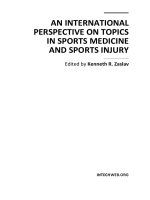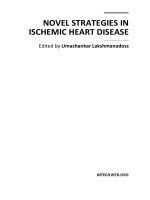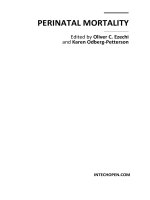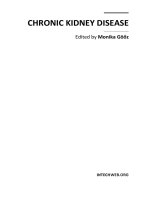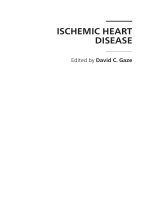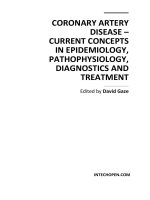Ischemic Heart Disease Edited by David C. Gaze doc
Bạn đang xem bản rút gọn của tài liệu. Xem và tải ngay bản đầy đủ của tài liệu tại đây (7.44 MB, 210 trang )
ISCHEMIC HEART
DISEASE
Edited by David C. Gaze
Ischemic Heart Disease
/>Edited by David C. Gaze
Contributors
Junichi Taki, Magda Youssef, Karina M. Mata, Fabio Carmona, Marcela S. Oliveira, Simone G. Ramos, Anastasia Susie
Mihailidou, Rebecca Ritchie, Anthony Ashton, Nadegda Pozdnyakova, Suli Zhang, Jin Wang, Yunhui Du, Jianyu Shang,
Li Wang, Jie Wang, Ke Wang, Kehua Bai, Tingting Lv, Xiao Li, Huirong Liu, Guijing Wang, Yigang Wang, Ghulam
Naroo, David Gaze
Published by InTech
Janeza Trdine 9, 51000 Rijeka, Croatia
Copyright © 2013 InTech
All chapters are Open Access distributed under the Creative Commons Attribution 3.0 license, which allows users to
download, copy and build upon published articles even for commercial purposes, as long as the author and publisher
are properly credited, which ensures maximum dissemination and a wider impact of our publications. After this work
has been published by InTech, authors have the right to republish it, in whole or part, in any publication of which they
are the author, and to make other personal use of the work. Any republication, referencing or personal use of the
work must explicitly identify the original source.
Notice
Statements and opinions expressed in the chapters are these of the individual contributors and not necessarily those
of the editors or publisher. No responsibility is accepted for the accuracy of information contained in the published
chapters. The publisher assumes no responsibility for any damage or injury to persons or property arising out of the
use of any materials, instructions, methods or ideas contained in the book.
Publishing Process Manager Danijela Duric
Technical Editor InTech DTP team
Cover InTech Design team
First published February, 2013
Printed in Croatia
A free online edition of this book is available at www.intechopen.com
Additional hard copies can be obtained from
Ischemic Heart Disease, Edited by David C. Gaze
p. cm.
ISBN 978-953-51-0993-8
free online editions of InTech
Books and Journals can be found at
www.intechopen.com
Contents
Preface VII
Chapter 1 Introduction to Ischemic Heart Disease 1
David C. Gaze
Chapter 2 Myocardial Ischemia in Congenital Heart Disease:
A Review 15
Fabio Carmona, Karina M. Mata, Marcela S. Oliveira and Simone G.
Ramos
Chapter 3 Significance of Arterial Endothelial Dysfunction and
Possibilities of Its Correction in Silent Myocardial Ischemia and
Diabetes Mellitus 41
I.P. Tatarchenko, N.V. Pozdnyakova, O.I. Morozova, A.G. Mordovina,
S.A. Sekerko and I.A. Petrushin
Chapter 4 Sex Differences in Sudden Cardiac Death 61
Anastasia Susie Mihailidou, Rebecca Ritchie and Anthony W.
Ashton
Chapter 5 Costs of Hospitalizations with a Primary Diagnosis of Acute
Myocardial Infarction Among Patients Aged 18-64 Years in the
United States 77
Guijing Wang, Zefeng Zhang, Carma Ayala, Diane Dunet and Jing
Fang
Chapter 6 Biomarkers of Cardiac Ischemia 91
David C. Gaze
Chapter 7 Is Hyperuricemia a Risk Factor to Cardiovascular Disease? 123
Magda H M Youssef
Chapter 8 Patient on ACS Pathway – Hypomagnesaemia a Contributory
Factor to Myocardial Ischemia 133
Ghulam Naroo, Tanveer Ahmed Yadgir, Bina Nasim and Omer Skaf
Chapter 9 Cell Autophagy and Myocardial
Ischemia/Reperfusion Injury 143
Suli Zhang, Jin Wang, Yunhui Du, Jianyu Shang, Li Wang, Jie Wang,
Ke Wang, Kehua Bai, Tingting Lv, Xiao Li and Huirong Liu
Chapter 10 Progenitor/Stem Cell Engineering for Treatment of Ischemic
Heart Diseases: Therapeutic Potentials and Challenges 163
Yuliang Feng, Yigang Wang and Shi-Zheng Wu
Chapter 11 Role of Fatty Acid Imaging with 123I- β-methyl-p-123I-
Iodophenyl-Pentadecanoic Acid (123I-BMIPP) in Ischemic Heart
Diseases 175
Junichi Taki, Ichiro Matsunari, Hiroshi Wakabayashi, Anri Inaki and
Seigo Kinuya
ContentsVI
Preface
Cardiovascular disease is ranked as the leading cause of death world wide. According to the
World Heart Federation, cardiovascular disease is responsible for 17.1 million deaths global‐
ly each year. A staggering 82% of these deaths actually occur in the developing world. Such
numbers are often difficult to comprehend. The gravity of the situation is enhanced when
portrayed as the following: A coronary even occurs every 25 seconds and CHD kills one
person every 34 seconds in the United States of America alone. 35 people under the age of 65
die prematurely in the United Kingdom every day due to cardiovascular disease (12,500
deaths per annum). Although the leading killer, the incidence of cardiovascular disease has
declined in recent years due to a better understanding of the pathological mechanisms in‐
volved and development of targeted therapeutics; along with the implementation of lipid
lowering therapy such as statins and new drug regimens including low molecular weight
heparin and antiplatelet drugs such as glycoprotein IIb/IIIa receptor inhibitors. Recent ad‐
vances in acute surgical intervention have also improved mortality, especially with the ad‐
vent of drug eluting stents and minimally invasive coronary artery bypass grafting, along
with improvements in cardioplegia and a systemic hypothermic environment.
The disease burden has a great financial impact on global healthcare systems and major eco‐
nomic consequences for world economies. Cardiovascular disease cost the UK healthcare
system £14.4 billion (€16.7 billion; $22.8 billion) in 2006. Hospital care for patients with car‐
diovascular disease accounts for approximately 70% of the cost with 20% spent on pharma‐
cological agents. The total cost should include non-healthcare costs such as production
losses in the workforce and
informal care of people with the disease. Production loss is esti‐
mated to cost the UK economy £8.2 billion in 2006 (55% due to death and 45% due to ill‐
ness). Informal care cost the UK economy £8.0 billion in 2006. Overall cardiovascular disease
is estimated to cost the UK economy £30.7 billion per annum.
This text firstly introduces the heart and circulation and the development and anatomy of
the coronary arteries before introducing the all encompassing umbrella of cardiovascular
disease and the Pathobiology of ischemic heart disease (IHD). The epidemiological burden
of Ischemic heart disease is described on a global scale; followed by risk factors, diagnostic
modalities and treatment regimens for IHD. The next chapter describes the deleterious ef‐
fects of congenital heart diseases and the role of myocardial ischemia in these conditions,
detailing the pathogenesis, diagnosis and treatment options before tacking strategies for
prevention. Chapter three demonstrates the gender disparity in sudden cardiac death
(SCD). SCD occurs predominantly in women often without previous symptoms or history of
CVD. The mechanisms surrounding SCD are detailed followed by identification of those at
risk and potential treatment strategies such as implantable cardioverter-defibrillators for
high risk subjects. Chapter four reports on the significance of endothelial function and its
relationship to silent myocardial ischemia, especially in patients with concomitant diabetes
mellitus. Damage to the endothelium is considered to be the initiation of the atherothrom‐
botic episode; be it chemically induced by reduction in nitric oxide, oxidative stress or in‐
flammation or by mechanical sheer stress and hemodynamic disruption. This is followed by
the presentation of clinical findings in sixty patients with CHD and type II diabetes Mellitus
compared to sixty eight patients with CHD but no evidence of diabetes. Using Holter ECG
monitoring, echocardiography, vascular Doppler ultrasound, the vascular responses be‐
tween those with and those without diabetes were measured. Furthermore, cerebrovascular
reactivity testing was also assessed. Patients with CHD and concomitant diabetes demon‐
strate reduced endothelium-dependent vasodilation compared to those CHD patients with‐
out CHD. As mentioned above, the economic cost of CHD is crippling healthcare budgets
and contributes to loss of business revenue and national reduction in gross domestic prod‐
uct. Chapter five from experts at the Centers for Disease Control and Prevention, USA sur‐
veyed inpatient admissions between 2006-8. Some 41,546 claims were made for a primary
diagnosis of acute myocardial infarction (46% ST segment elevation MI; STEMI). The associ‐
ated costs are highest in males than females and a geographical variation was observed.
STEMI costs were higher than non-STEMI costs and costs were highest in those undergoing
surgical revascularisation by primary coronary intervention or coronary artery bypass graft‐
ing. These data could be used to model more cost-effective AMI intervention programs. The
next chapter details the biochemical tests available for the detection and diagnosis of cardiac
ischemia. There are a plethora of candidate biomarkers however very few have made the
transition to use in the clinical setting. Biomarkers up stream
of the cardiac troponins may
serve as sensitive tests, but at the cost of specificity thus reducing the overall diagnostic effi‐
ciency of the test. Malondialdehyde low-density lipoprotein, Myeloperoxidase, whole blood
choline, and free fatty acids are described. The FDA cleared Ischemia Modified Albumin
assay is described in detail including its clinical utility not only in acute chest pain but in
those patients without acute coronary syndrome. Lastly, with the advent of sensitive cardiac
troponin tests, the ischemia vs necrosis debate is challenged once again. Chapter seven dis‐
cusses the role of uric acid (the end product of purine metabolism) as a risk factor for the
development of CVD. Similarly, the role of magnesium and the hypomagnesaemic state and
its relationship in the development of clinical disorders such as diabetes, hypertension, athe‐
rosclerosis and acute coronary syndrome are discussed in the subsequent chapter. Chapter
nine investigates the process of ‘self-eating’ or autophagy, detailing the intracellular signal‐
ling control mechanisms and its role in the maintenance of normal myocardial tissue and its
cardioprotective effect during ischemia in the hypoxic myocardium. The understanding of
autophagy may lead to possible therapeutic targets for IHD. The penultimate chapter is con‐
cerned with progenitor and stem cell engineering as a possible intervention to treat IHD.
This is of great interest given recent advances in understanding progenitor cell biology but
also poses many considerable challenges in transferring from laboratory based science into a
clinical reality. The chapter reviews recent progress in progenitor and stem cell engineering,
including cell sources, scaffold free tissue construct, myocardial tissue generation using de‐
cellularised native tissue, porous scaffolding and biosynthetic polymers. The final chapter of
this text discuses the role of fatty acid imaging, in which fatty acid tracers labelled with the
radioisotope of iodine, 123-I is used in single positron emission computer tomography
(SPECT) imaging. An overview of myocardial fatty acid metabolism is given, along with de‐
scription of the iodine-labelled tracers and their myocardial tissue kinetics. This is followed
by the clinical utility of the tracer in imaging post acute myocardial infarction, in those with
PrefaceVIII
stable chronic coronary artery disease, risk stratification and the assessment of myocardial
tissue viability and probably most importantly, prediction of functional recovery. Further‐
more, its role in chronic kidney disease is discussed in light of the high prevalence of CHD
in this unique population.
David C. Gaze
Dept of Chemical Pathology Clinical Blood Sciences,
St George’s Healthcare NHS Trust
London, United Kingdom
Preface IX
Chapter 1
Introduction to Ischemic Heart Disease
David C. Gaze
Additional information is available at the end of the chapter
/>1. Introduction
“The heart has its reasons which reason knows not.” Blaise Pascal (1623-1662)
The heart is the vital organ that tirelessly pumps oxygenated blood from the lungs to the organs
and peripheral tissues via the circulatory system. In return, deoxygenated blood is returned
via the heart and the pulmonary circulation to the lungs to expel waste carbon dioxide (figure
1). The average human heart beats approximately 72 beats per minute totalling around 2.5
billion beats in a 66-year lifespan. The human heart weighs 250-300g in females and 300-350g
in males. The heart is located in the mediastinum of the thorax, anterior to the vertebrae and
posterior to the sternum. Archosaurs (crocodilians and birds) as well as Mammalia species show
complete separation of the heart into two pumping units comprised of four distinct chambers.
The myogenic musculature of the heart is supplied by the coronary arteries and the entire
organ is held within the pericardial sac.
1.1. Development and anatomy of the coronary arteries
As with any organ, the heart requires its own supply of blood for continued functioning. The
supply of blood to the myocardium occurs via the coronary artery circuit (figure 2). Their name
is derived from the Latin ‘Corona’, meaning crown as the main vessels encircle the interven‐
tricular and atrioventricular grooves.
The arterial tree has two main compartments; firstly, the main arteries (table 1) and ramifica‐
tions on the surface of the myocardium, known as the extramural coronary system. Secondly,
the branches of the surface vessels which penetrate deep into the myocardial tissues are known
as the intramural coronary system.
© 2013 Gaze; licensee InTech. This is an open access article distributed under the terms of the Creative
Commons Attribution License ( which permits unrestricted use,
distribution, and reproduction in any medium, provided the original work is properly cited.
The extramural coronary system is formed from two main arteries. The left coronary artery
(LCA) and the right coronary artery (RCA). A third vessel exists in up to 50% of the population
and is known as the conus artery. The diameters of the vessels are given in table 1. The
intramural coronary system is a complex vascular network containing the main intramural
branches which have region specific distribution patterns. The ventricular branches arise at
right angles from the subepicardial arteries taking an endocardial route. An important
component of the intramural system is the collateral or anastomotic arterial system. These
vessels have a characteristic corkscrew appearance. They are present at birth and do not differ
in distribution by age or gender. In the normal heart they are 20-350 μm in diameter.
Figure 1. Anterior view of the human heart with blood vessels identified
Ischemic Heart Disease2
Figure 2. Coronary artery anatomy. a) Left coronary artery and b) Right coronary artery. A, atrial branch; AM, acute
marginal artery; AVCx, atrioventricular groove branch of circumflex; AVN, atrioventricular node artery; CB, conus
branch; D, diagonal branch of LAD; LAC, left atrial circumflex; LAD, left anterior descending; LAO 30° left anterior obli‐
que projection; LAT, left lateral projection; LMS, left main stem; LV, left ventricular branches; MCx, main circumflex; PD,
posterior descending; PLCx, posterior circumflex branch (obtuse marginal); RA, right atrial branch; RAO, 30o right an‐
terior oblique projection; RV, right ventricular branch; S, septal perforating arteries; SN, sinus node artery.
Introduction to Ischemic Heart Disease
/>3
Vessel Median Diameter (range) in mm
LEFT CORONARY ARTERY (LCA) 4 (2.5-5.5)
Left anterior descending 3.6 (2-5)
DG diagonal 2 (0.5-2.5)
LCX circumflex 3 (1.5-5)
LMG marginal 2.2 (1-3)
RIGHT CORONARY ARTERY (RCA) 3.2 (1.5-5.5)
RMG marginal 1.7 (1-2.5)
PD posterior descending 2.1 (1-3)
THIRD CORONARY ARTERY ‘conus artery’ 1.1 (0.7-2)
Septal branches anterior from LCX 1 (0.5-2.5)
Septal branches posterior from PD 0.7 (0.3-0.9)
From ascending LAD 0.4 (0.3-0.7)
Table 1. The major coronary arteries.
The primitive embryonic heart is nourished via lacunar or intertrabeclar spaces, forming a net-
like structure separating bundles of muscle fibres. Further evolutionary development results
in endothelial budding. Originally this was thought to derive from the coronary sinus and
aorta, forming superficial veins and arteries which penetrate into the myocardial tissue joining
the lacunar spaces. It was then demonstrated in chick-quail chimaeras that the vessels were
derived from the proepicardium structure common to the embryo and undergo a transition
from epithelial to mesenchymal tissue. Mouse studies refute this, suggesting that the proepi‐
cardium gives rise to myocardial stroma and vascular smooth muscle but not coronary artery
endothelial cells. Using clonal and histological analysis in the mouse, Red-Horse and collea‐
gues (Red-Horse et al. 2010) demonstrate that coronary arteries are formed by developmental
reprogramming of venous cells, arising from angiogenic sprouts of the sinus venosus which
returns blood to the embryonic heart. The understanding of angiogenesis in the myocardium
may in future lead to more natural methods to stimulate vascular growth and engineering
coronary bypass grafts rather than transplanting veins to revascularize damaged myocardium.
2. Cardiovascular disease
A variety of diseases affect the primary functioning of the heart. Cardiovascular disease (CVD)
is the collective name for diseases of the heart and blood vessels of the circulatory system. An
atlas of types of cardiovascular diseases in the heart and in the circulation are given in table 2.
International efforts have been implemented to classify and code the different types of ischemic
heart diseases. A number of notable indexing databases such as the International Classification
of Diseases database, Disease Database eMedicine and MeSH databases have produced
indexing codes. These are given in table 3.
Ischemic Heart Disease4
Cardiovascular Disease
Diseases of the Heart Diseases of the Circulation
Angina Pectoris Aortic aneurysm
Stable Angina
Unstable Angina Aortitis
Variant (Prinzmetal’s) Angina
Arteriosclerosis
Arrhythmia
Heart block (first-degree and second-degree and
complete AV block)
Atherosclerosis
Premature atrial complex
Atrial flutter Aortic dissection
Paroxysmal supraventricular tachycardia
Wolff-Parkinson-White syndrome Hypertension
Premature ventricular complex Essential (primary) hypertension
Ventricular tachycardia Secondary hypertension
Ventricaular fibrillation Malignant hypertension
Long QT syndrome
Stroke (Cerebrovascular accident)
Cardiomyopathy
Dilated Cardiomyopathy Transient ischemic attack
Hypertropic Cardiomyopathy
Restrictive Cardiomyopathy Arterial disease
Arterial embolus
Congestive heart failure Acute arterial occlusion
Raynaud’s phenomenon
Congenital heart disease Arteriovenous fistula
Atrial septal defect Vasculitis
Ventricular septal defect Thoracic outlet syndrome
Patent ductus arteriosus
Introduction to Ischemic Heart Disease
/>5
Cardiovascular Disease
Diseases of the Heart Diseases of the Circulation
Pulmonary stenosis Venous disease
Congential aortic stenosis Venous thrombosis
Teratology of Fallot Deep vein thrombosis
Tricuspid atresia Varicose veins
Truncus arteriosus Spider veins
Ebstein’s abnormality of the tricuspid valve
Great vessel transposition Lymphedema
Coronary artery disease
Ischemic heart disease
Acute myocardial infarction
Cor pulmonale
Heart valve disease
Mitral stenosis
Mitral valve regurgitation
Mitral valve prolapse
Aortic stenosis
Aortic regurgitation
Tricuspid stenosis
Tricuspid regurgitation
Myocarditis
Rheumatic disease
Pericarditis
Sudden cardiac death
Syncope
Cardiac tumours
Myxoma
Table 2. Atlas of cardiovascular diseases of the heart and circulatory system.
Ischemic Heart Disease6
Classification system Code
International Classification of Diseases (ICD-9)
World Health Organisation,
Geneva, Switzerland
410 Acute Myocardial infarction (AMI)
411 Other acute and subsequent forms of Ischemic Heart
Disease
412 Old Myocardial Infarction
413 Angina Pectoris
414 Other forms of chronic ischemic heart disease
International Classification of Diseases (ICD-10)
World Health Organisation,
Geneva, Switzerland
120 Angina Pectoris
121 Acute Myocardial Infarction (AMI)
122 Subsequent Myocardial Infarction
123 Certain current complications following AMI
124 Other acute ischemic heart diseases
125 Chronic ischemic heart disease
Diseases Database (DiseaseDB)
Medical Object Oriented Software Enterprises
Ltd London UK
8695 - Ischemic or Ischaemic Heart disease, Myocardial
Ischaemia, Steoncardia, Angina Pectoris, Coronary Artery
Arteriosclerosis, IHD
eMedicine (WebMD)
New York, USA
Med/1568 – Angina Pectoris
Medical Subject headings (MeSH)
Unites States National Library of Medicine
Bethesda, Maryland, USA
D017202 – Myocardial Ischemia
Table 3. Classification codes of Ischemic Heart Disease
3. Pathobiology of ischemic heart disease
Hypoxia refers to the physiological or pathological state in which oxygen supply is reduced
despite adequate perfusion of the tissue. Anoxia is the absence of oxygen from the tissue,
despite being adequately perfused. These are clearly distinguishable from ischemia where
oxygen supply is restricted as a direct result of suboptimal tissue perfusion. Ischemic tissue
also accumulates toxic metabolites due to the inadequate removal through the capillary and
venous blood systems.
The atherosclerotic process responsible for restriction of blood flow in the coronary arteries is
a multifactorial process and is initiated by damage to the endothelium. Cholesterol rich low
density lipoprotein (LDL) particles enter the intimal layer via the LDL receptor protein (Brown
and Goldstein 1979), a mosaic cell surface protein that recognizes apolipoprotein B100
embedded in the LDL particle. It also recognizes apolipoprotein E found in chylomicrons and
very low density lipoprotein remnants, or intermediate density lipoprotein. Macrophage cells
accumulate oxidized lipid independently of the LDL receptor by endocytosis. This results in
formation of juvenile raised fatty streaks within the endothelium. The macrophage release
their lipid content and cytokines into the intima. Cytokines stimulate intimal thickening by
Introduction to Ischemic Heart Disease
/>7
smooth muscle cell proliferation, which then secrete collagen, causing fibrosis (figure 3). The
lesion appears raised and yellow.
Figure 3. Medium powered H&E histological micrograph of an intimal lesion (x200). FC, foam cell infiltrate; IC, intimal
calcification; L, lumen; TI, tunica intima; TM, tunica media.
As the lesion develops, the medial layer of the vessel wall atrophies and the elastic lamina
becomes disrupted. Collagen forms a fibrous cap over the lesion that appears hard and white
(known as a fibrolipid plaque). The plaque contains macrophage laden with lipid (foam cells)
as well as extracellular or ‘free’ lipid within the lesion. The endothelium is now in a fragile
state. Ulceration of the cap occurs at weak points such as the shoulder region, near the
endothelial lining. Rupture to the cap can cause turbulent blood flow in the lumen. The exposed
lipid core causes aggregation of platelets and development of a thrombosis. This lesion grows
due to further platelet aggregation and is responsible for narrowing of the lumen of the artery
resulting in localized ischemia. Distal embolization of a piece of such thrombus may travel
downstream and can completely occlude smaller arteries.
The symptomatic part of the continuum is known as the acute coronary syndrome (ACS) which
is due to the rupture/erosion of the plaque. This produces, depending on the plaque size,
vascular anatomy and presence of collateral vessels, a mismatch between the supply and
demand for oxygen. A net reduction in supply compared to the demand results in ischemia.
Tissue hypoxia proceeds resulting in inadequate blood/oxygen perfusion. If blood flow is not
re-established, cardiac cell necrosis will occur. Post AMI survival results in remodelling
processes in the myocardium and the development of cardiac failure.
Ischemic Heart Disease8
4. Epidemiology of ischemic heart disease
According to the World Health Organisation, chronic diseases of which heart disease is the
single largest contributing category; are responsible for 63% of all global deaths (United
Nations High-Level Meeting on Noncommunicable Disease Prevention and Control 2012).
Non communicable diseases kill 9 million people under the age of 60 every year which has a
profound socio-economic impact.
The incidence of Ischemic heart disease (IHD) is higher than for any cancer or other non-CVD
condition. Cardiovascular diseases (CVD) are the leading cause of death in the Western World
and are dramatically increasing within developing countries. The Age-standardized estimate
of mortality by cardiovascular diseases and diabetes per 100,000 people is given in figure 4.
17.1 million people die as a direct result of CVD per year and 82% of these deaths occur in the
developing word
It is predicted that by 2030 23 million people will die from a CVD. Data from the USA suggests
that CVD was responsible for 34% of deaths in 2006 and over 151,000 Americans who died
were <65 years old. The incidence of CVD is declining in the Western World even though rates
of lifestyle associated risk factors such as obesity, smoking and type II diabetes mellitus are
increasing. The decline is in part due to advances in therapeutic and invasive intervention. In
creating better outcomes for those with acute cardiac conditions, patients develop heart failure
which requires longer term treatment and monitoring and may in fact be a greater health
burden than the acute events themselves.
Figure 4. Age-standardized estimate of mortality by cardiovascular diseases and diabetes per 100,000 people. Source:
Global Health Observatory Data Repository, World Health Organisation.
Introduction to Ischemic Heart Disease
/>9
5. Risk factors
There is no single causative risk factor for the development of IHD. A number of genetic and
environmental risk factors have been established as causative in the development of the
atherosclerotic lesion. Smoking and obesity cause 36% and 20% of IHD respectively. A large
European meta-analysis of 197,473 participants reported an small association between job
stress and the development of coronary artery disease (Kivimaki et al. 2012). There has been
extensive research linking a sedentary lifestyle and a lack of exercise with a risk of IHD. The
major risk factors for the development of IHD are given in table 4.
Constant risk factors Modifiable risk factors
Age Hypercholesterolaemia/dyslipidaemia
Gender Hypertension
Family history of IHD Obesity (particularly central abdominal obesity)
Personal history of early IHD Tobacco and passive tobacco Smoking
Diabetes Mellitus type I Excessive alcohol consumption
Elevated homocysteine Diabetes Mellitus type II
Elevated haemostatic factors Sedentary lifestyle
Baldness & hair greying Low antioxidant levels
Earlobe crease (Frank’s sign) Infection
Air pollution (CO, NO
2
, SO
2
)
Combined oral contraceptive pill
Table 4. Risk factors for the development of Ischaemic Heart Disease.
6. Signs and symptoms of ischemic heart disease
Ischemia may manifest in many forms. Most commonly, patients present with chest pain on
exertion, in cold weather or in emotional situations. This discomfort is known as angina
pectoris. Patients may present with acute chest pain at rest which typically radiates down the
left arm and up the left side of the neck. Patients may experience nausea, vomiting, sweating
and enhanced anxiety. Symptomatically, women present with less ‘textbook’ symptoms and
often describe their condition as weakness, indigestion and fatigue (Kosuge et al. 2006). Up to
60% of AMI are referred to as silent without any observation of chest pain or other symptoms
(Valensi et al. 2011).
Angina is diagnosed by evidence of deviation of the ST segment on the electrocardiogram,
reduced uptake of thallium-201 during myocardial perfusion imaging or regional or global
impairment of ventricular function. In patients with stable angina often have chest pain on
Ischemic Heart Disease10
exertion. Patients benefit from cardiac stress testing, echocardiography. If indicated patients
should receive coronary angiography to locate anatomically any stenosis with a view to
revascularisation by stenting during percutaneous coronary intervention or coronary artery
bypass grafting (CABG) surgery.
7. Diagnosis of ischemic heart disease
In the primary care setting, patients may be suspected of having ischemic heart disease based
on risk factor assessment and blood chemistry tests such as lipid profiling, inflammatory
markers and homocysteine concentration.
Primarily the diagnosis of IHD occurs in the acute setting when patients present with symp‐
tomatic chest pain. Patients often present with a myriad of symptoms which confuse the clinical
picture. Patients should receive immediate electrocardiography and pharmacological or
surgical intervention in those who demonstrate ST-segment elevation in the context of ST-
segment myocardial infarction (STEMI). In suspected non-ST segment elevation myocardial
infarction (NSTEMI) patients should undergo serial venepuncture for cardiac biomarkers,
namely the cardiac troponins which are indicative of myocyte necrosis. Patients may undergo
stress testing, whereby the stress response is induced by exercise or pharmacological agents
allowing comparison of the coronary circulation at rest and under stress. Patients are moni‐
tored continuously whilst exercising on a treadmill, on a ergometer bicycle or following
injection of agents such as adenosine, the adenosine A2A receptor Regadenoson or the beta-
agonist dobutamine. The agent of choice is dependent on drug interactions with medication
or concomitant disease states.
Cardiac ultrasound or echocardiography by two-dimensional, three-dimensional or Doppler
ultrasound create images of the myocardium at work. Transthoracic echocardiogram (TTE) is
the commonest form and the ultrasound transducer probe is placed non-invasively on the
thorax. Transoesophageal echogram (TOE) is an alternative method where the transducer tip
is passed into the oesophagus, allowing imaging directly behind the heart.
8. Treatment of ischemic heart disease
Stable IHD patients can be adequately treated in the primary care setting with emphasis on
both lifestyle and risk factor modifications to reduce the risk of a future adverse cardiac event.
Modification of lifestyle risk factors such as smoking cessation and weight loss control have a
direct impact on risk reduction. Further intervention such as treating hypertension, glycaemic
control in diabetics and therapeutic intervention in hyperlipidaemia result in risk reduction.
Furthermore, elective revascularisation of occluded coronary arteries may confer a reduction
in mortality risk compared to conservative therapy. A meta-analysis of 13,121 patients in
whom 6476 were randomised to revascularisation compared to medical treatment in the
Introduction to Ischemic Heart Disease
/>11
remainder demonstrated that bypass grafting and Percutaneous coronary intervention are
superior to medical therapy alone with respect to 1-10 year mortality (Jeremias et al. 2009).
Patients with symptomatic chest pain suggestive of an AMI and ST segment elevation should
receive immediate revascularisation. Fibrinolytic therapy should be administered within 30
minutes and door-to-balloon PCI should occur in no more than 90 minutes from the onset of
pain. For non ST segment elevation AMI patients, treatment with aspirin, glycoprotein IIb/IIIa
inhibitor such as clopidogrel, low molecular weight heparin, glyceryl trinitrate and opioid
therapy for persistent pain.
9. Conclusion
Ischemic heart disease is the major contributing cause of death in the Western World and the
incidence is increasing in developing countries. Successful advances in surgical and thera‐
peutic intervention are able to salvage myocardial tissue and increase prognosis if adminis‐
tered in the early phase following injury.
Author details
David C. Gaze
Department of Chemical Pathology Clinical Blood Sciences, St. George’s Healthcare NHS
Trust, London, UK
References
[1] Brown, M. S, & Goldstein, J. L. (1979). Receptor-mediated endocytosis: insights from
the lipoprotein receptor system. Proc.Natl.Acad.Sci.U.S.A , 76, 3330-3337.
[2] Jeremias, A, Kaul, S, Rosengart, T. K, Gruberg, L, & Brown, D. L. (2009). The impact
of revascularization on mortality in patients with nonacute coronary artery disease.
Am.J.Med. , 122, 152-161.
[3] Kivimaki, M, Nyberg, S. T, Batty, G. D, Fransson, E. I, Heikkila, K, Alfredsson, L,
Bjorner, J. B, Borritz, M, Burr, H, Casini, A, Clays, E, De Bacquer, D, Dragano, N, Fer‐
rie, J. E, Geuskens, G. A, Goldberg, M, Hamer, M, Hooftman, W. E, Houtman, I. L,
Joensuu, M, Jokela, M, Kittel, F, Knutsson, A, Koskenvuo, M, Koskinen, A, Kouvo‐
nen, A, Kumari, M, Madsen, I. E, Marmot, M. G, Nielsen, M. L, Nordin, M, Oksanen,
T, Pentti, J, Rugulies, R, Salo, P, Siegrist, J, Singh-manoux, A, Suominen, S. B, Vaana‐
nen, A, Vahtera, J, Virtanen, M, Westerholm, P. J, Westerlund, H, Zins, M, Steptoe, A,
Ischemic Heart Disease12
& Theorell, T. (2012). Job strain as a risk factor for coronary heart disease: a collabora‐
tive meta-analysis of individual participant data. Lancet , 380, 1491-1497.
[4] Kosuge, M, Kimura, K, Ishikawa, T, Ebina, T, Hibi, K, Tsukahara, K, Kanna, M, Iwa‐
hashi, N, Okuda, J, Nozawa, N, Ozaki, H, Yano, H, Nakati, T, Kusama, I, & Ume‐
mura, S. (2006). Differences between men and women in terms of clinical features of
ST-segment elevation acute myocardial infarction. Circ.J. , 70, 222-226.
[5] Red-horse, K, Ueno, H, Weissman, I. L, & Krasnow, M. A. (2010). Coronary arteries
form by developmental reprogramming of venous cells. Nature , 464, 549-553.
[6] United Nations High-Level Meeting on Noncommunicable Disease Prevention and
Control. (2012).
[7] Valensi, P, Lorgis, L, & Cottin, Y. (2011). Prevalence, incidence, predictive factors and
prognosis of silent myocardial infarction: a review of the literature. Arch.Cardio‐
vasc.Dis. , 104, 178-188.
Introduction to Ischemic Heart Disease
/>13
Chapter 2
Myocardial Ischemia in
Congenital Heart Disease: A Review
Fabio Carmona, Karina M. Mata,
Marcela S. Oliveira and Simone G. Ramos
Additional information is available at the end of the chapter
/>1. Introduction
1.1. Concepts
Patients with congenital heart disease (CxHD) are surviving into adulthood, as well as living
longer and growing older [1], due the major achievements in their diagnosis, medical man‐
agement, surgical repair, and postoperative treatment in the last three to four decades. An
increasing numbers of patients with CxHD are encountered in our everyday practice. It is
therefore timely and appropriate to start addressing the somewhat-neglected issue of myo‐
cardial ischemia in this patient population [2].
CxHD is, by definition, cardiovascular disease present at birth. It refers to anatomic defects
and gross cardiac abnormalities due to an embryologic malformation in the structural
development of the heart and major blood vessels, which is actually of functional significance
[3]. Most CxHD occur due to gross structural developmental cardiovascular anomalies such
as septal defects, stenosis or atresia of valves, hypoplasia or absence of one ventricle, or
abnormal connections between great vessels and the heart. A few children are also born with
arrhythmias (mainly conduction defects), and hypertrophic or dilated cardiomyopathy,
although these are usually present later in childhood or adulthood. CxHD are the most
common of all congenital malformations, with a reported incidence of 6 to 8 cases per 1,000
live births, and in an even higher percentage of foetuses [4]. In some studies this incidence
reaches 12 to 14 per 1,000 live births [5].
There is a great number of recognized heart defects occurring alone and in combination,
ranging in severity from hemodynamically insignificant to extremely complex and life
threatening conditions (Table 1). Although there may be genetic or environmental situations
© 2013 Carmona et al.; licensee InTech. This is an open access article distributed under the terms of the
Creative Commons Attribution License ( which permits
unrestricted use, distribution, and reproduction in any medium, provided the original work is properly cited.


